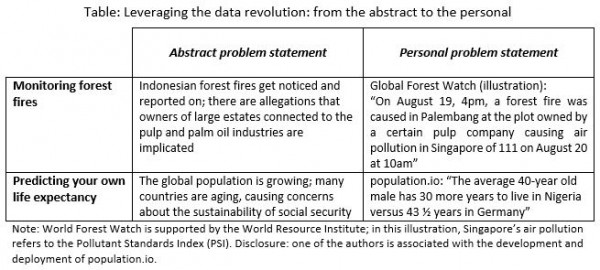Wolfgang Fengler and Homi Kharas in the Financial Times: “When world leaders meet this week for the UN’s general assembly to adopt the Sustainable Development Goals (SDGs), they will also call for a “data revolution”. In a world where almost everyone will soon have access to a mobile phone, where satellites will take high-definition pictures of the whole planet every three days, and where inputs from sensors and social media make up two thirds of the world’s new data, the opportunities to leverage this power for poverty reduction and sustainable development are enormous. We are also on the verge of major improvements in government administrative data and data gleaned from the activities of private companies and citizens, in big and small data sets.
But these opportunities are yet to materialize in any scale. In fact, despite the exponential growth in connectivity and the emergence of big data, policy making is rarely based on good data. Almost every report from development institutions starts with a disclaimer highlighting “severe data limitations”. Like castaways on an island, surrounded with water they cannot drink unless the salt is removed, today’s policy makers are in a sea of data that need to be refined and treated (simplified and aggregated) to make them “consumable”.
To make sense of big data, we used to depend on data scientists, computer engineers and mathematicians who would process requests one by one. But today, new programs and analytical solutions are putting big data at anyone’s fingertips. Tomorrow, it won’t be technical experts driving the data revolution but anyone operating a smartphone. Big data will become personal. We will be able to monitor and model social and economic developments faster, more reliably, more cheaply and on a far more granular scale. The data revolution will affect both the harvesting of data through new collection methods, and the processing of data through new aggregation and communication tools.
In practice, this means that data will become more actionable by becoming more personal, more timely and more understandable. Today, producing a poverty assessment and poverty map takes at least a year: it involves hundreds of enumerators, lengthy interviews and laborious data entry. In the future, thanks to hand-held connected devices, data collection and aggregation will happen in just a few weeks. Many more instances come to mind where new and higher-frequency data could generate development breakthroughs: monitoring teacher attendance, stocks and quality of pharmaceuticals, or environmental damage, for example…..
Despite vast opportunities, there are very few examples that have generated sufficient traction and scale to change policy and behaviour and create the feedback loops to further improve data quality. Two tools have personalised the abstract subjects of environmental degradation and demography (see table):
- Monitoring forest fires. The World Resources Institute has launched Global Forest Watch, which enables users to monitor forest fires in near real time, and overlay relevant spatial information such as property boundaries and ownership data to be developed into a model to anticipate the impact on air quality in affected areas in Indonesia, Singapore and Malaysia.
- Predicting your own life expectancy. The World Population Program developed a predictive tool – www.population.io – showing each person’s place in the distribution of world population and corresponding statistical life expectancy. In just a few months, this prototype attracted some 2m users who shared their results more than 25,000 times on social media. The traction of the tool resulted from making demography personal and converting an abstract subject matter into a question of individual ranking and life expectancy.
A new Global Partnership for Sustainable Development Data will be launched at the time of the UN General Assembly….(More)”
